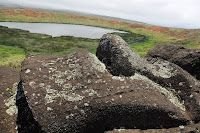
a moai not yet removed from the volcano quarry where it was made
Tongariki moais - 15 in total which have been re-erected
cave we clambered through
There are numerous underground caves near the west coast of the island, previously inhabited by the Rapa Nui, which can be seen from the remainder of many small walls left inside. There are still islanders today who remember times before the arrival of the first aeroplanes. They speak of being brought up in the caves, fetching water daily from the freshwater lake in the volcano crater. They have a history of being persecuted by the people who arrived after the explorers, including Peruvian slave traders who kidnapped many of them and later, a sheep farming company who took over the land surrounding Hanga Roa village, hemming the last of the population in. Many also died when smallpox and TB were brought to the island by continentals. In the 19th century only 111 natives remained. Since 1963, when the island was granted freedom, the population has significantly recovered and modern day life on the island is different to how it was only a generation before. Three aeroplanes daily bring tourists with money to spend in the local community, on souvenirs of hand carved statues and shell necklaces and hiring either cars, scooters or quads to tour the sites. The younger Rapa Nui generation is split between those who remain and those who leave for the continent, although when asked most would admit to wanting to return to the island at some point. There is a strong connection with the ancestral history and culture and a pride in being part of the most isolated community on earth. We explore the caves, amazed at the fact we can walk 200 metres underground through pitch black tunnels. We head back to the pretty beach at Anakena for a last dip in the huge waves of the Pacific Ocean before cooking our last meal in the Mihinoa Camping Hostel and chatting with some fellow travellers who’ve just been to New Zealand and only had great things to say about it.
.jpg)
.jpg)
.jpg)
.jpg)
.jpg)

.jpg)
.jpg)
.jpg)
.jpg)
.jpg)
.jpg)

